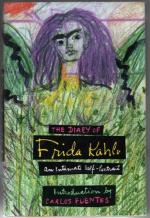
|
| Name: _________________________ | Period: ___________________ |
This test consists of 15 multiple choice questions and 5 short answer questions.
Multiple Choice Questions
1. Frida created an list of words beginning with the same letter. What letter did she use?
(a) A.
(b) M.
(c) X.
(d) C.
2. Frida created a double portrait surrounded by small images. Which of the following images are close to her face in this portrait?
(a) An Egyptian pyramid.
(b) A Chinese yin-yang sign.
(c) A faithful copy of the Mexico City's National Palace bell.
(d) Saturn.
3. As her health began to decline, what kinds of images did Frida create fewer of?
(a) Portraits of Diego.
(b) Self-portraits.
(c) Images created from spilled ink.
(d) Images with veins.
4. What line of work was Frida's father in?
(a) Baking.
(b) Banking.
(c) Photography.
(d) Music.
5. Lowe quotes Kahlo as writing that anguish and pain were both which of the following?
(a) Processes.
(b) Necessary parts of life.
(c) Never fully embraced.
(d) Challenges.
6. In Frida's "portrait of Nefertidos," which cultures does Frida combine?
(a) Mexican, American, and French.
(b) French, German, and Italian.
(c) Aztec, Hindu, and Egyptian.
(d) Mayan, German, and Egyptian.
7. What does Frida write on the page that she fills with faces in bubbles?
(a) "Must stay separate."
(b) "You can't take them anywhere."
(c) "How ugly people are!"
(d) "Not a friendly face in the crowd!"
8. How does Carlos Fuentes claim he first met Frida Kahlo?
(a) He smelled her perfume.
(b) He heard her.
(c) He had to ask her to take care of her dog.
(d) He was introduced by a mutual friend.
9. What are the carpas that Fuentes describes?
(a) A term for the typical cooking utensils that Adelitas, women who participated in the Revolution, typically carried on their backs.
(b) A term for old neighborhoods, like Coyoacan, that were once separate from Mexico City, but became part of the city as it grew.
(c) Layers of "resentimiento," or popular resentment as the ideals of the Revolution were touted as realized in government.
(d) Tents that were the stage for satire in proletariat "barrios."
10. What figures can be found in the image that Frida labeled "Naturaleza bien muerta"?
(a) A pile of what appears to be vomit.
(b) An eagle.
(c) A hanging hand.
(d) A spoon.
11. What does Lowe claims motivate Kahlo's writing the Diary?
(a) "Doodling when she was in too much pain to paint formally."
(b) "Drafting what would later become formal paintings."
(c) "Understanding her complicated romantic life."
(d) "Negotiating her relationship to her self."
12. How long does Lowe write that Frida kept this Diary?
(a) Ten years.
(b) Fifteen years.
(c) Five years.
(d) One year.
13. Who does Lowe write does Frida draw in the Diary and use in a painting titled Moses?
(a) Andre Breton.
(b) Engles.
(c) Moses.
(d) Nefertiti.
14. Frida creates an image of herself falling apart from the top of a column. What does she label this image?
(a) I am disintegration.
(b) The pain is overwhelming.
(c) Where is Diego?
(d) The great fall.
15. As Frida's health declined, what does Lowe claim she painted more and more of?
(a) Skeletons.
(b) Fruits and vegetables.
(c) Images of couples.
(d) Nudes.
Short Answer Questions
1. What aspect of Rembrandt and Van Gogh's work does Lowe compare to Kahlo's?
2. Which of the following best describes the mood of Frida's cold weather image?
3. Which of the following best describe Frida's feeling for her husband?
4. What does Lowe claim was the guiding principal behind Surrealism?
5. How does Lowe write that students remembered Frida?
|
This section contains 559 words (approx. 2 pages at 300 words per page) |

|




